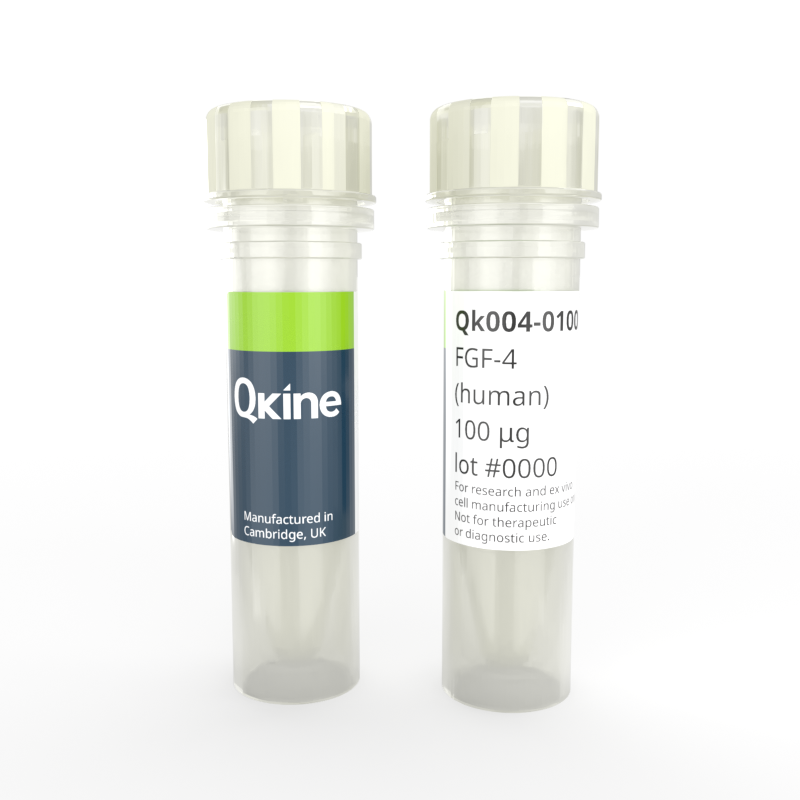Recombinant human FGF-4 protein
QK004
Brand: Qkine
Human fibroblast growth factor 4 (FGF-4) protein is used for the proliferation and differentiation of embryonic and induced-pluripotent and tissue (mesenchymal) stem cells and promotes neural stem cell proliferation. Recombinant FGF-4 is an important component of cardiac, intestinal and other organoid culture media.
High purity and bioactivity 14 kDa, bioactive domain of human FGF-4, animal origin-free (AOF) and carrier-protein free.

Currency:
| Product name | Catalog number | Pack size | Price | Price (USD) | Price (GBP) | Price (EUR) |
|---|---|---|---|---|---|---|
| Recombinant human FGF-4 protein, 25 µg | QK004-0025 | 25 µg | (select above) | $ 210.00 | £ 155.00 | € 182.00 |
| Recombinant human FGF-4 protein, 50 µg | QK004-0050 | 50 µg | (select above) | $ 340.00 | £ 250.00 | € 292.00 |
| Recombinant human FGF-4 protein, 100 µg | QK004-0100 | 100 µg | (select above) | $ 325.00 | £ 310.00 | € 363.00 |
| Recombinant human FGF-4 protein, 500 µg | QK004-0500 | 500 µg | (select above) | $ 1370.00 | £ 1000.00 | € 1168.00 |
| Recombinant human FGF-4 protein, 1000 µg | QK004-1000 | 1000 µg | (select above) | $ 2110.00 | £ 1540.00 | € 1799.00 |
Note: prices shown do not include shipping and handling charges.
Qkine company name and logo are the property of Qkine Ltd. UK.
Alternative protein names
Species reactivity
human
species similarity:
mouse – 91%
rat – 80%
porcine – 91%
bovine – 90%
Frequently used together:
Summary
- High purity human FGF-4 protein (residues 79-206, Uniprot: P08620)
- 14 kDa
- >98%, by SDS-PAGE quantitative densitometry
- Animal origin-free (AOF) and carrier protein-free
- Expressed in E. coli
- Manufactured in Qkine's Cambridge, UK laboratories
- Lyophilized from HEPES, NaCl, mannitol
- Resuspend in sterile-filtered water at >50 µg/ml, add carrier protein if desired, prepare single use aliquots and store frozen at -20 °C (short-term) or -80 °C (long-term).
Featured applications
- Hindgut organoids from iPSC-derived human posterior gut endoderm cells
- Neural stem cell proliferation and neuronal differentiation
Bioactivity
FGF-4 activity was determined using the firefly luciferase reporter assay in stably transfected HEK293T cells. Cells are treated in triplicate with a serial dilution of FGF-4. Firefly luciferase activity is measured and normalized. EC50 = 306.5 pM (4.3 ng/mL). Data from Qk004 lot #104330.
.jpg?width=400&height=400&name=Qk004-product-page-bioactivity-1%20(1).jpg)
Purity
Recombinant human FGF-4 protein migrates as a single band at 14 kDa in non-reducing conditions (NR) and upon reduction (R). No contaminating protein bands are visible. Purified recombinant protein (7 µg) was resolved using 15% w/v SDS-PAGE in reduced (+β-mercaptothanol, R) and non-reduced conditions (NR) and stained with Coomassie Brilliant Blue R250. Data from Qk004 lot #010.
.jpg?width=400&height=400&name=human-FGF-4-Qk004-protein-purity-lot-010-1%20(1).jpg)
Further quality assays
- Mass spectrometry: single species with expected mass
- Recovery from stock vial: >95%
- Endotoxin: <0.005 EU/μg protein (below level of detection)
.jpg?width=400&height=288&name=Qk004-comaprison-Datasheet-graph_-Data%20(1).jpg)
Qkine FGF-4 bioactivity is comparable to an alternative supplier protein. Quantitative luciferase assay with Qkine FGF-4 (Qk004, green) and alternative supplier FGF-4 (Supplier B, black). Cells were treated in triplicate with a serial dilution of FGF-4 for 3 hours. Firefly luciferase activity was measured and normalized to control Renilla luciferase activity.
Protein background
Fibroblast growth factor 4 (FGF-4) is a member of the FGF superfamily with a physiological role in the regulation of proliferation and differentiation in embryonic stem cells and tissue stem cells [1-3] .
Recombinant human FGF-4 protein promotes neural stem cell proliferation and neuronal differentiation in the postnatal brain [4], increases the proliferation rate of human adult bone-marrow derived mesenchymal stem cells [5] and supports the maintenance, proliferation and self-renewal properties of human embryonic stem cells [6].
Synergism between FGF-4 and WNT signalling acts to form hindgut organoids from iPSC-derived human posterior gut endoderm cells [7] and recombinant human FGF-4 protein is used to mimic embryonic intestinal development during directed differentiation in culture of pluripotent stem cells into intestinal organoids.
Background references
- Beenken, A. & Mohammadi, M. The FGF family: biology, pathophysiology and therapy. Nat. Rev. Drug Discov. 8, 235–53 (2009). doi.org/10.1038/nrd2792
- Coutu, D. L. & Galipeau, J. Roles of FGF signaling in stem cell self-renewal, senescence and aging. Aging (Albany. NY). 3, 920–33 (2011).
- Kosaka, N., Sakamoto, H., Terada, M. & Ochiya, T. Pleiotropic function of FGF-4: Its role in development and stem cells. Dev. Dyn. 238, 265–276 (2009). doi.org/10.1002/dvdy.21699
- Kosaka, N. et al. FGF-4 regulates neural progenitor cell proliferation and neuronal differentiation. FASEB J. 20, 1484–1485 (2006). doi:10.1096/fj.05-5293fje
- Farré, J. et al. FGF-4 increases in vitro expansion rate of human adult bone marrow-derived mesenchymal stem cells. Growth Factors 25, 71–76 (2007). doi.org/10.1080/08977190701345200
- Mayshar, Y. et al. Fibroblast Growth Factor 4 and Its Novel Splice Isoform Have Opposing Effects on the Maintenance of Human Embryonic Stem Cell Self-Renewal. Stem Cells 26, 767–774 (2008). doi.org/10.1634/stemcells.2007-1037
- Zhang, R.-R. et al. Human iPSC-Derived Posterior Gut Progenitors Are Expandable and Capable of Forming Gut and Liver Organoids. Stem Cell Reports 10, 780–793 (2018). doi.org/10.1016/j.stemcr.2018.01.006
FAQ
What is the function of the FGF receptor?
FGFRs phosphorylate specific tyrosine residues and activate the RAS-MAPK, PI3K-AKT, PLCγ, and STAT intracellular signaling pathways.